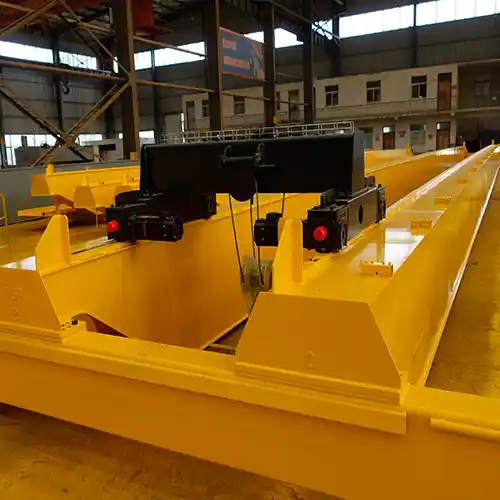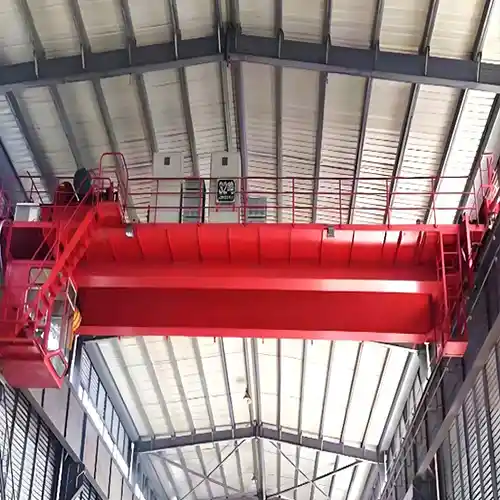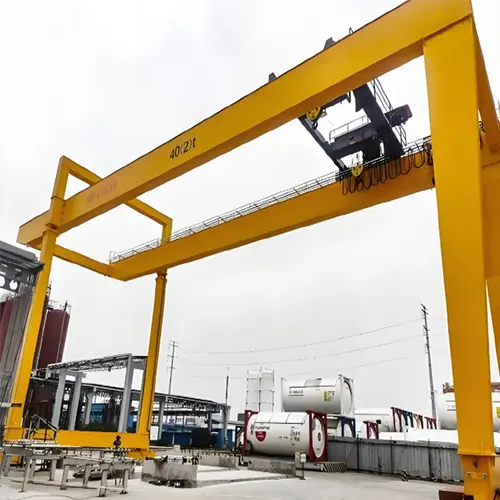Floor Operated Cranes | Pendant & Remote Control Overhead Cranes
Floor Operated Crane for sale. Pendant & remote control floor operated cranes, i.e, overhead cranes & gantry Cranes & jib cranes for sale, economical price.
Category: Floor Mounted Crane
Your Trusted Overhead Bridge Crane Manufacturer & Supplier
Floor Operated Cranes: Pendant & Remote Control Overhead Cranes
Floor Operated Crane for sale. Pendant & remote control floor operated cranes, i.e, overhead cranes & gantry Cranes & jib cranes for sale, economical price.
Exploring the Power of Floor-Operated Cranes in Modern Industries
A floor-operated crane is a type of crane that is controlled and operated from the ground level, typically using a control panel or remote control device. Unlike some other types of cranes that require operators to be situated in an elevated cab or control room, a floor-operated crane allows operators to manage crane movements, lifting, and lowering operations while being on the same level as the load and the surrounding environment.
These cranes are commonly used in various industries, including manufacturing, construction, warehouses, and shipping yards. They come in different configurations and capacities, such as overhead cranes, gantry cranes, and jib cranes. The floor-operated feature offers several advantages:
- Better Visibility: Operators have a direct line of sight to the load and the surrounding area, improving safety and accuracy during lifting and maneuvering.
- Ease of Operation: The controls are typically more intuitive and straightforward, allowing operators to quickly learn and use the crane effectively.
- Flexibility: Operators can easily move around the crane and the load, adjusting their position as needed for optimal control.
- Safety: Operators can maintain a closer distance to the load, making it easier to communicate with ground personnel and respond to any issues promptly.
- Reduced Infrastructure: These cranes often don't require the construction of a dedicated operator cab or control room, which can save costs and space.
It's important to note that while floor-operated cranes offer advantages, their suitability depends on the specific lifting tasks and operational requirements of a given situation. Safety guidelines and proper training for crane operators are crucial to ensure smooth and secure operations.
The Crucial Role of Crane Operations Across Industries
Cranes are the backbone of industries that deal with heavy materials, intricate assembly, and efficient material handling. From manufacturing plants that create massive machinery to construction sites that raise skyscrapers, the importance of cranes cannot be overstated. Consider the task of moving tons of raw materials within a factory or positioning large components for assembly – these tasks demand precision, strength, and above all, safety.
In the realm of manufacturing, floor-operated cranes enable operators to oversee the movement of materials and parts, ensuring seamless workflow and minimizing the risk of accidents. Construction sites, often characterized by their dynamic and evolving environments, benefit from the agility of floor-operated cranes, allowing operators to adapt to changing conditions swiftly. Warehouses and distribution centers, where efficient storage and retrieval of goods are paramount, leverage these cranes to streamline operations and optimize space.
Unveiling the Purpose of Floor-Operated Cranes
At the heart of the popularity of floor-operated cranes lies their purpose – to bridge the gap between power and precision. These cranes offer a range of advantages that make them indispensable assets across industries. The proximity of operators to the load enhances visibility, enabling them to make informed decisions while maneuvering heavy objects. The intuitive controls of floor-operated cranes translate to quicker training and reduced learning curves for operators.
Flexibility in operator positioning is another key advantage. Operators can easily adjust their position relative to the load, responding promptly to changing requirements on the ground. Additionally, the reduced need for dedicated operator cabs or control rooms translates to cost savings and efficient use of space.
In the next segments of this blog, we'll delve deeper into the types of floor-operated cranes, explore their intricate control systems, and discuss their applications in various industries. Join us as we uncover the inner workings and undeniable benefits of these ground-level giants.
Types of Floor-Operated Cranes
When it comes to heavy lifting and efficient material handling, floor-operated cranes offer a diverse range of configurations, each tailored to specific needs and environments. Let's explore the various types of floor-operated cranes that have become the workhorses of modern industry.
Overhead Cranes
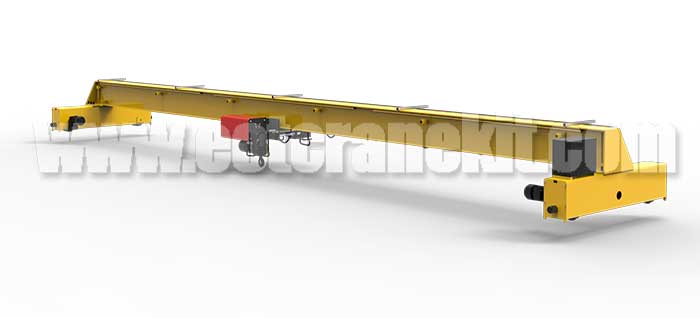
Single Girder Overhead Cranes:
- Features: Boasting simplicity and cost-effectiveness, single girder overhead cranes flaunt a singular horizontal beam (girder) elegantly upheld by end trucks. Ideal for moderate lifting duties and spaces with restricted headroom, these cranes shine in scenarios where precision meets economy.
- Benefits: These cranes optimize space utilization, rendering them fitting for manufacturing units, warehouses, and assembly lines, where precision and efficiency dictate success.
- Crane Controller: Pendant control stations or push button control stations provide direct and intuitive control, allowing operators to manage movements with precision.
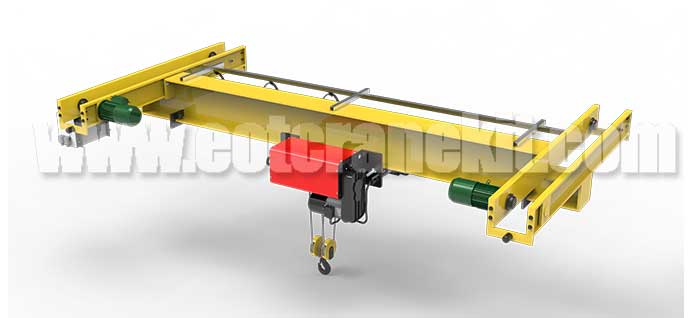
Double Girder Overhead Cranes:
- Features: Enter double girder overhead cranes, champions of augmented lifting capabilities and adaptability. With two girders harmoniously aligned, these cranes present amplified stability and load-bearing prowess. Engineered for heavy loads and extended spans, they respond effectively to the demands of industries seeking formidable lifting prowess.
- Benefits: This crane type thrives in domains such as steel mills, foundries, and construction sites, where robust lifting of weighty materials is the norm.
- Crane Controller: Joystick control stations or radio remote controls provide seamless control over complex movements and heavy loads.
Gantry Cranes

Rail-Mounted Gantry Cranes (RMGs):
- Features: RMGs, designated as rail-mounted gantry cranes, dance through container terminals and shipping yards. These agile movers traverse tracks embedded in the ground, orchestrating seamless motion along storage expanses. RMGs bring vertical stacking mastery to the forefront, revolutionizing container handling practices.
- Benefits: Their knack for optimizing storage space and expediting container management establishes them as essential assets in logistics.
- Crane Controller: Radio remote controls equipped with advanced features such as anti-collision systems ensure precise control and safe operation.

Rubber-Tired Gantry Cranes (RTGs):
- Features: Introducing RTGs, the nimble navigators of terminals and yards. With rubber tires facilitating fluid movement across paved terrains, these cranes bestow agility and swiftness to container handling. The ability to roam varied landscapes renders them indispensable in versatile container management scenarios.
- Benefits: RTGs redefine mobility, enabling flexible maneuvering within container terminals and depots.
- Crane Controller: Radio remote controls provide operators with the freedom to control the crane from a safe distance, enhancing safety and efficiency.
Jib Cranes
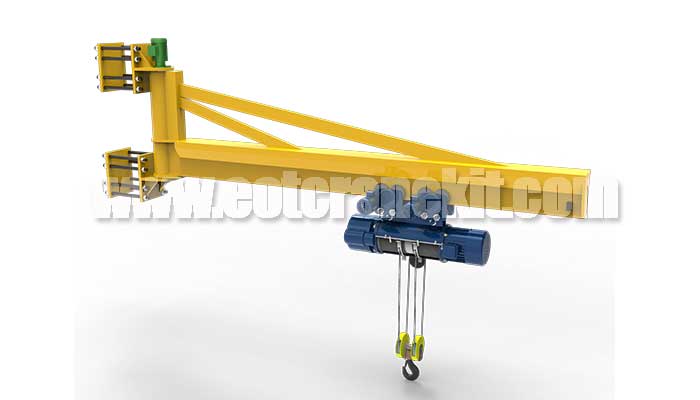
- Features: Elegantly poised as wall-bound companions, jib cranes transform constrained areas into zones of precision. The fixed radius of operation ensures meticulous material manipulation within a defined sphere. Workshops, manufacturing cells, and maintenance facilities benefit from this localized expertise.
- Benefits: Wall-mounted jib cranes masterfully handle tasks demanding calculated positioning within confined domains.
- Crane Controller: Pendant control stations with ergonomic designs allow operators to easily manage jib movements within limited spaces.
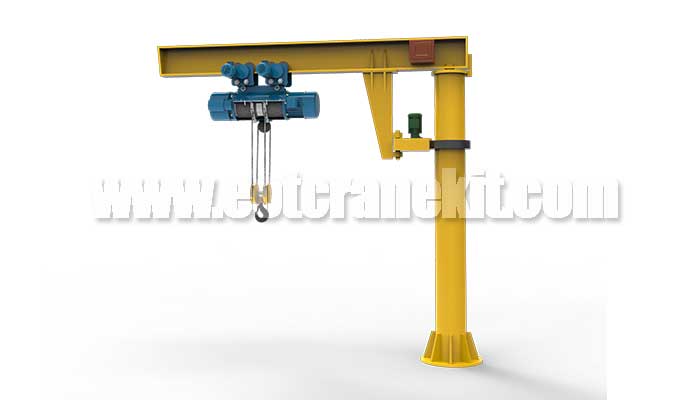
- Features: Enter freestanding jib cranes, freewheeling powerhouses crowned with a vertical post and horizontal jib arm. Versatility reigns supreme, as these cranes grant a broader range of motion compared to their wall-bound counterparts. From loading docks to open-air environments, they redefine spatial dynamics.
- Benefits: Freestanding jib cranes thrive where overhead space is scarce and dynamic load maneuvering is the norm.
- Crane Controller: Joystick control stations provide precise control over the jib arm's movement, enabling accurate load positioning.
In this eclectic universe of floor-operated cranes, distinct personas cater to a rich tapestry of industrial requirements, from intricate finesse to robust heft. Our journey ventures deeper as we unravel the intricate control systems, bestowing operators with the reins to conduct these mechanical marvels with elegance and precision.
Features and Components
In the intricate world of floor-operated cranes, the seamless orchestration of movements is made possible by a combination of finely engineered features and components. These elements come together to transform these mechanical giants into versatile tools capable of tackling a wide array of lifting challenges.
Control Panel: The Nerve Center of Precision
- Functions and Buttons: The control panel of a floor-operated crane serves as the nerve center, enabling operators to execute precise movements. Rows of buttons and switches allow operators to control crane motions including hoisting, trolley movement, and bridge traversal. Emergency stop buttons provide an instant way to halt operations in critical situations, ensuring safety remains paramount.
- Remote Control Options: The advent of technology has brought about the evolution of crane control systems. Remote control options, including handheld transmitters or radio frequency devices, offer operators the freedom to maneuver the crane from a distance. This enhanced flexibility is particularly valuable in scenarios where visibility and safety are priorities.
Hoist Mechanism: Lifting Power in Motion
- Wire Rope Hoists: Wire rope hoists are versatile and commonly used for various lifting applications. They utilize a system of wire ropes wound around a drum to lift heavy loads with precision. Wire rope hoists are known for their durability, resistance to wear, and smooth lifting motions.
- Chain Hoists: Chain hoists employ a chain loop to lift loads. They are compact, reliable, and capable of handling a broad range of weights. Chain hoists are often favored for their simplicity and ease of maintenance.
Trolley System: Seamless Movement Across the Span
- Manual Trolley: Manual trolley systems allow operators to move the crane horizontally along the beam manually. These systems are straightforward and require physical effort from operators. They are commonly used in scenarios with lighter loads and limited horizontal travel.
- Electric Trolley: Electric trolley systems enhance operator convenience by enabling motorized horizontal movement. Operators can control the trolley's position from the control panel, facilitating smoother and more precise load positioning.
Lifting Mechanism: Precision Placement
- Hook Block: The hook block is the primary attachment for lifting loads. It consists of a hook suspended from a pulley system. Operators can attach various lifting accessories to the hook block, allowing for precise positioning and secure attachment of loads.
- Grab Bucket (for specific applications): In applications that involve bulk material handling, such as in mining or construction, grab buckets are used. These specialized attachments allow the crane to grip and release bulk materials like sand, gravel, or debris.
Load Capacity and Specifications: Engineering Excellence
The load capacity of a floor-operated crane depends on its design and components. Manufacturers specify the maximum weight a crane can safely lift and move. This information guides operators in making informed decisions about load management and ensures that operations remain within safe parameters.
As we venture deeper into the realm of floor-operated cranes, we'll explore the advantages they offer, their real-world applications, and the vital role they play in shaping the efficiency and safety of industries worldwide.
Differences of different floor operated crane controllers
Different types of floor-operated crane controllers vary in terms of design, features, and functionality. Here's a comparison of the key differences between various floor-operated crane controllers:
- Design: Handheld device with buttons and switches connected to the crane by a cable.
- Features: Basic controls for crane movements (hoist, trolley, bridge). Limited space for additional features.
- Advantages: Direct control, tactile feedback, simple interface.
- Limitations: Operator mobility is limited by the cable length, limited space for additional functions.
Master Control Panel:
- Design: Fixed control station on the ground with buttons, switches, and possibly joysticks.
- Features: More functions and options compared to pendant controls. Digital displays for load information, emergency stops, etc.
- Advantages: More features, better visibility of crane status, suitable for more complex tasks.
- Limitations: Operator mobility is confined to the control panel location.
- Design: Handheld wireless transmitter communicating with a receiver on the crane.
- Features: Mobility, ability to control crane from a distance, some models offer multiple channels for different functions.
- Advantages: Flexibility, improved visibility, safety through distance from potential hazards.
- Limitations: Requires batteries or charging, potential for signal interference.
Touchscreen Control Panel:
- Design: Control panel with a touchscreen interface for controlling crane movements and functions.
- Features: Intuitive graphical interface, potentially customizable layouts, may include load monitoring.
- Advantages: User-friendly, adaptable, potential for advanced features.
- Limitations: Susceptible to physical damage, learning curve for operators unfamiliar with touchscreen controls.
Automation and PLC Controllers:
- Design: Centralized control system based on programmable logic controllers (PLCs) or automation systems.
- Features: Pre-programmed sequences of movements, automated tasks, data logging, integration with other systems.
- Advantages: High level of automation, improved efficiency, reduced operator input required.
- Limitations: Requires programming expertise, may be costlier to implement and maintain.
Each type of controller has its own advantages and limitations, and the choice depends on factors such as the crane's size, application, level of automation desired, operator preferences, and safety considerations. Ultimately, the goal is to select a controller that allows for safe, efficient, and accurate crane operations in the specific operational environment.
Floor operated crane remote controllers vs pendant controllers
Operating floor-operated cranes using remote controllers and pendant controllers introduces distinct approaches to control and management. Let's delve into the differences between these two control methods for two different types of floor-operated cranes: the overhead crane and the jib crane.
Floor Operated Overhead Crane:
Remote Controller:
- Description: With a remote controller, operators manage the crane's movements wirelessly from a safe distance using a handheld device.
- Advantages: Remote controllers provide enhanced operator mobility and visibility. Operators can position themselves strategically for optimal visibility of the load and the surroundings. This control method is particularly useful for tasks that require precise positioning and navigation.
- Benefits: Improved safety by allowing operators to maintain a safe distance from the load and the crane's movements. Reduces the risk of accidents and collisions. Operators have a broader field of view for better load management.
Pendant Controller:
- Description: Pendant controllers consist of a handheld pendant device connected to the crane by cables. Operators control the crane's functions by manipulating the buttons and switches on the pendant.
- Advantages: Pendant controllers offer direct physical connection to the crane, providing a tactile feel for movements. Operators can closely observe load movements and make immediate adjustments.
- Benefits: Pendant controllers are suitable for tasks that require precise control, such as positioning heavy loads with accuracy. They are often used in scenarios where real-time adjustments are crucial.
Floor Operated Gantry Cranes:
Remote Controller:
- Description: Remote controllers allow operators to control gantry crane movements wirelessly from a distance, similar to the previously mentioned crane types.
- Advantages: Gantry cranes are often used in outdoor environments and large open spaces. Remote control provides operators with the freedom to move around the yard or facility while maintaining control over the crane's movements.
- Benefits: Operators can navigate the crane with agility, especially in scenarios where the crane needs to cover extensive distances or access hard-to-reach areas. This control method enhances operational efficiency and versatility.
Pendant Controller:
- Description: Pendant controllers for gantry cranes function similarly to those for overhead and jib cranes, with a handheld pendant device connected to the crane by cables.
- Advantages: Pendant controllers provide operators with direct control over gantry crane movements, ensuring immediate response and precision.
- Benefits: Gantry cranes are often used for tasks such as loading and unloading shipping containers and heavy materials. Pendant control enables operators to accurately position and manipulate loads, ensuring safe and efficient material handling.
Comparing Remote and Pendant Controllers for Gantry Cranes:
- Mobility: Remote controllers offer higher mobility, allowing operators to move around a larger area while maintaining control. This is particularly useful for gantry cranes that cover expansive outdoor spaces.
- Flexibility: Remote control provides the flexibility to adjust the crane's movements from various vantage points, facilitating efficient load management.
- Precision: Pendant controllers offer direct and tactile control, allowing operators to make precise adjustments in load positioning. This is crucial for tasks that require accurate placement.
- Visibility: Both control methods enhance operator visibility. Remote control allows operators to position themselves optimally, while pendant control ensures close observation of load movements.
- Obstacle Navigation: Remote controllers are advantageous when navigating around obstacles or structures within the crane's path.
- Safety: Both control methods contribute to safety by enabling operators to maintain a safe distance from the crane's movements.
Ultimately, the choice between remote and pendant control for gantry cranes depends on factors such as the specific application, the environment, the required precision, and operator preferences. Both control methods offer benefits that can be harnessed to optimize the efficiency and safety of gantry crane operations.
Floor Operated Jib Crane:
Remote Controller:
- Description: Similar to overhead cranes, remote controllers allow operators to control jib crane movements wirelessly from a distance.
- Advantages: Remote control provides flexibility and convenience, allowing operators to move freely around the work area while maintaining control over the crane. This is especially valuable in confined spaces.
- Benefits: Operators can navigate around obstacles and safely position themselves for optimal visibility while controlling the jib crane. This control method enhances productivity and safety.
Pendant Controller:
- Description: Pendant controllers for jib cranes function similarly to those for overhead cranes, with a handheld pendant device connected to the crane by cables.
- Advantages: Pendant control ensures direct and immediate control over the jib crane's movements. Operators can precisely position loads within the jib arm's radius.
- Benefits: Pendant controllers are ideal for tasks that demand careful load manipulation and placement, such as moving items onto a specific workstation or assembly area.
In summary, both remote controllers and pendant controllers offer their own set of advantages and benefits for floor-operated cranes. The choice between the two depends on factors such as the type of crane, the specific tasks being performed, the operator's preferences, and safety considerations. Remote controllers provide mobility and flexibility, while pendant controllers offer tactile control and direct connection to the crane. Each control method enhances the efficiency and safety of material handling operations.
Crane Controls for Floor Operated Cranes
The crane controls for floor-operated cranes vary based on the specific type of crane and its manufacturer, but they generally include a set of standard controls and components that allow the operator to maneuver the crane effectively. Here are the common crane controls found in floor-operated cranes:
1. Main Power Switch: This switch activates or deactivates the power supply to the crane.
2. Emergency Stop Button: A prominent red button that immediately stops all crane movements in case of an emergency.
3. Hoist Control: Controls the vertical movement of the load. Depending on the type of hoist (chain hoist or wire rope hoist), the controls might include:
- - Hoist Up/Down Buttons: Raise or lower the load.
- - Hoist Speed Control: Adjust the lifting speed.
- - Emergency Lowering Control: Gradually lowers the load in case of power failure.
4. Trolley Control: Manages the horizontal movement of the load along the beam or track. Controls might include:
- - Trolley Left/Right Buttons: Move the trolley along the beam.
- - Trolley Speed Control: Adjust the trolley movement speed.
- - Trolley Brake Control: Engage or disengage the trolley brake.
5. Bridge Control: For overhead and gantry cranes, this control manages the movement of the entire crane structure along the rails. Controls might include:
- - Bridge Forward/Reverse Buttons: Move the crane along the rails.
- - Bridge Speed Control: Adjust the bridge movement speed.
- - Bridge Brake Control: Engage or disengage the bridge brake.
6. Radio Remote Control: Some floor-operated cranes offer the option of a handheld radio remote control, allowing the operator to control the crane from a distance, providing flexibility and better visibility of the load.
7. Load Control: In cranes with specialized lifting mechanisms (e.g., grabs or magnets), additional controls may be present to manage the attachment and release of the load.
8. Limit Switches: Safety devices that prevent the crane from traveling beyond predefined limits, ensuring safe operations.
9. Indicator Lights: These lights provide visual feedback about the crane's status, such as power on, emergency stop engaged, or load lifted.
10. Overload Warning System: Alerts the operator if the load being lifted exceeds the crane's rated capacity.
11. Horn or Alarm: An audible signal that alerts personnel in the vicinity of crane movements, enhancing safety.
12. Control Panel Display: Some modern cranes feature a digital display that provides information about load weight, crane position, and other relevant data.
It's important for operators to receive proper training on these controls to ensure safe and efficient crane operations. Different manufacturers might have variations in the layout and labeling of controls, so it's advisable to refer to the crane's user manual or seek guidance from qualified personnel.
Advantages of Floor-Operated Cranes
In the dynamic landscape of industrial operations, the utilization of floor-operated cranes has ushered in a new era of efficiency, safety, and precision. These mechanical marvels come with a host of advantages that make them indispensable assets across various sectors. Let's explore the key advantages that have positioned floor-operated cranes at the forefront of modern lifting solutions.
- Improved Visibility and Line of Sight One of the standout features of floor-operated cranes is the direct line of sight they offer to operators. Unlike traditional cranes that require operators to peer down from elevated cabs, floor-operated cranes keep operators at ground level, enabling them to maintain an unobstructed view of the load, the surroundings, and potential obstacles. This heightened visibility translates to enhanced accuracy in load positioning, minimizing the risk of collisions and accidents.
- Ease of Operation and Control The intuitive nature of floor-operated crane controls plays a pivotal role in their widespread adoption. Operators can quickly grasp the functions of buttons, switches, and levers, enabling them to operate the crane with confidence. This ease of operation not only reduces the learning curve for new operators but also contributes to faster task execution and seamless coordination of movements.
- Flexibility in Operator Positioning Floor-operated cranes empower operators with the flexibility to move around the crane and the load as needed. This adaptability is particularly valuable in scenarios where the load needs to be accurately positioned in confined spaces or where obstacles need to be navigated. The ability to position oneself in close proximity to the load fosters a hands-on approach to crane operations, resulting in increased control and efficiency.
- Enhanced Safety and Communication Safety is paramount in industrial environments, and floor-operated cranes contribute significantly to creating a secure workspace. Operators' presence at ground level facilitates direct communication with ground personnel, enabling them to relay instructions and receive real-time feedback. The reduced distance between operators and the ground also enables quicker response to emergencies, as operators are closer to emergency stop buttons and can take immediate action if needed.
- Reduced Infrastructure Requirements Unlike traditional cranes that often require the construction of operator cabs or control rooms at elevated heights, floor-operated cranes have reduced infrastructure demands. This translates to cost savings and efficient space utilization. The absence of dedicated cabs also means that operators are more integrated with the work environment, fostering better communication and collaboration with colleagues.
The advantages presented by floor-operated cranes extend their influence across industries, from manufacturing and construction to logistics and heavy equipment maintenance. As we continue our exploration, we'll delve into the diverse applications that harness these advantages to streamline operations and elevate industrial efficiency.
Applications of Floor-Operated Cranes
Floor-operated cranes, with their unique features and advantages, find their niche across a wide spectrum of industries, transforming the way heavy lifting and material handling are accomplished. Let's explore how these versatile mechanical giants play a crucial role in various industrial landscapes.
- Manufacturing Industries: Precision at the Heart- In manufacturing plants, where precision and efficiency are paramount, floor-operated cranes rise to the occasion. They enable operators to effortlessly move heavy components, position intricate machinery, and facilitate seamless assembly processes. Whether it's lifting raw materials, positioning large workpieces, or aiding in complex manufacturing operations, these cranes ensure that the manufacturing floor operates like a well-oiled machine.
- Construction Sites: Building the Future- The dynamic and evolving environment of construction sites demands flexible and adaptable lifting solutions. Floor-operated cranes step up to the challenge by providing operators with the tools to move heavy materials, transport equipment, and assist in erecting structures. Their ability to navigate tight spaces and handle various load types makes them indispensable assets in shaping the skylines of cities around the world.
- Warehouses and Distribution Centers: Efficient Storage and Retrieval- In the realm of logistics, floor-operated cranes contribute to the smooth operation of warehouses and distribution centers. They play a vital role in stacking, organizing, and retrieving goods from shelves and storage racks. With their agility and precision, these cranes optimize space utilization, reduce handling times, and ensure timely delivery of products to end customers.
- Shipping Yards and Ports: Managing Cargo with Finesse- Shipping yards and ports form the backbone of global trade, and the efficiency of cargo handling is of utmost importance. Floor-operated cranes, whether rail-mounted or rubber-tired gantry cranes, excel in the management of shipping containers. They facilitate the loading and unloading of vessels, arrange containers in precise stacks, and contribute to the rapid turnover of cargo, ensuring that goods reach their destinations efficiently.
- Heavy Equipment Maintenance: Keeping Operations Running- Maintaining heavy equipment, whether in construction, mining, or industrial plants, requires careful handling and precise positioning. Floor-operated cranes provide the necessary lifting power to hoist heavy machinery and components, allowing maintenance teams to carry out repairs, inspections, and replacements with accuracy. These cranes contribute to minimizing downtime and maximizing operational uptime.
The applications of floor-operated cranes extend beyond these sectors, permeating industries that rely on the efficient movement of heavy loads. As we venture further, we'll explore the diverse control options that empower operators to orchestrate these cranes with finesse and navigate them through complex operational landscapes.
Safety Considerations
In the realm of industrial operations, safety stands as a cornerstone that cannot be compromised. Floor-operated cranes, despite their efficiency and capabilities, must be operated with a steadfast commitment to safety. Let's delve into the essential safety considerations that ensure the well-being of operators, equipment, and the entire work environment.
- Operator Training and Certification: The First Line of Defense- The skill and competence of crane operators are paramount to safe operations. Proper training and certification ensure that operators are well-versed in crane controls, maneuvers, emergency procedures, and load management. Ongoing training keeps operators updated with best practices, safety regulations, and the latest technological advancements, equipping them to handle the complexities of crane operations with confidence.
- Load Capacity Awareness: Staying Within Safe Limits- One of the cardinal rules in crane operation is respecting load capacity limits. Operators must be acutely aware of the crane's rated load capacity and never exceed it. Overloading a crane can lead to catastrophic failure, endangering personnel and property. It's imperative to consider not only the weight of the load but also its size, shape, and potential dynamic forces during lifting and movement.
- Adherence to Safety Protocols: Operating by the Book- Safety protocols and procedures are in place to prevent accidents and ensure the consistent application of safe practices. Operators must adhere to established protocols, including proper rigging techniques, load securing, and communication procedures. Regular safety briefings and toolbox talks foster a safety-conscious mindset among the entire team, promoting a culture of responsibility and accountability.
- Regular Maintenance and Inspections: Ensuring Mechanical Integrity- A well-maintained crane is a safe crane. Regular maintenance and inspections are crucial to identifying potential issues before they escalate. Components such as wire ropes, chains, brakes, and electrical systems require routine checks to detect wear, corrosion, or malfunction. Prompt repairs and proactive maintenance contribute to the longevity and reliability of the crane while minimizing the risk of accidents.
As we continue to marvel at the capabilities of floor-operated cranes, let's remember that their power must be harnessed within a framework of unwavering commitment to safety. By embracing these considerations, industries can ensure that these cranes remain steadfast allies in the pursuit of efficient and secure operations.
Factors Influencing Selection
Selecting the right floor-operated crane for a specific application involves careful consideration of several factors. From the nature of the loads to be lifted to the available budget, these elements play a pivotal role in determining the optimal crane solution. Let's explore the key factors that guide the selection process and ensure that the chosen crane aligns with operational needs.
- Types of Loads to Be Lifted: Tailoring the Crane to the Task- The diversity of loads within an industry necessitates a crane that can handle various weights, sizes, and shapes. Different types of cranes are suited for specific load profiles. For instance, single girder overhead cranes may be ideal for lighter loads, while double girder overhead cranes excel in handling heavier materials. Understanding the characteristics of the loads to be lifted allows for a crane selection that aligns with lifting requirements.
- Available Space and Layout: Maximizing Utilization- The spatial configuration of the operational area influences the choice of crane design. Overhead cranes are optimal when vertical space is abundant, while gantry cranes prove advantageous in wide and open spaces. The crane's footprint, travel path, and clearance requirements must harmonize with the available space to ensure seamless movement and efficient material handling.
- Operational Environment and Conditions: Adapting to Challenges- Operating conditions, such as temperature extremes, humidity, dust, and corrosive elements, impact the longevity and performance of floor-operated cranes. In corrosive environments, selecting cranes with protective coatings or materials that resist corrosion is essential. Cranes intended for outdoor use should be designed to withstand changing weather conditions and offer durability against environmental factors.
- Budget and Cost Considerations: Balancing Investment- The selection of a floor-operated crane is ultimately influenced by budget considerations. While it's tempting to focus solely on upfront costs, a comprehensive assessment includes long-term costs associated with maintenance, repairs, and operational efficiency. Balancing the initial investment with the expected returns over the crane's lifecycle ensures that the chosen crane offers value and meets budgetary constraints.
As industries explore the wide array of floor-operated crane options, understanding and evaluating these influential factors streamline the decision-making process. The harmonization of load requirements, spatial layout, operational environment, and financial considerations paves the way for a crane that seamlessly integrates into the industrial landscape, elevating efficiency and productivity.
Conclusion
In the field of heavy lifting and precise material handling, floor-operated cranes stand as pivotal assets that bridge engineering innovation with industrial demands. These cranes, controlled from the ground level, bring a multitude of advantages to industries worldwide.
From improved visibility and ease of operation to flexibility in operator positioning and enhanced safety, floor-operated cranes offer a winning combination of features that redefine operational efficiency. They empower operators to orchestrate movements with finesse, contributing to streamlined workflows and reduced risks.
However, with great power comes great responsibility. Proper training, load capacity awareness, adherence to safety protocols, and regular maintenance form the bedrock of a safety-conscious environment. By placing safety at the forefront, industries ensure that the potential of floor-operated cranes is harnessed responsibly.
As we conclude our exploration, it's clear that these cranes play a dynamic role in modern industrial operations. They lift, position, and empower industries to reach new heights. With each movement they execute, floor-operated cranes silently contribute to the progress of manufacturing, construction, logistics, and beyond. As industries continue to evolve, these cranes remain steadfast partners in driving innovation and efficiency forward.
Main Projects
Related Products

Supplied three grab bucket crane kits to Indonesia, enhancing garbage handling efficiency with high load capacity and reliable performance.
Free consultation to Confirm Parameters & Specifications and Get
Latest Crane Price & Crane Rate.
- Types of overhead cranes : _______?
- Optional: Overhead travelling crane, goliath gantry crane,Slewing jib crane, Single girder or double girder crane,small portable crane or kbk crane, etc.
- Capacity of overhead crane: _______?
- Optional: 0.25ton, 0.5 ton, 1 ton, 2 ton, 3ton, 5 ton, 10 ton,15ton, 20ton, 25 ton, 30ton,35ton, up to 550ton, etc.
- Crane span & lifting height : _______?
- Crane travelling length : _____?
- Control of overhead crane:_______?
- Optional: pendant/ remote/cabin control
- Voltage supply of overhead crane:_____?
- Eg,: 380V50/60HZ,3Phase or others,etc.
- Application/usage of crane:_______?
- Eg,: Steel mill, ,injection mold, cement,stone, concrete,granite, general manufacturing, etc.
Just leave a message via the contact form and our hoist and crane engineer will contact you with in 24working hours.
Get In Touch
